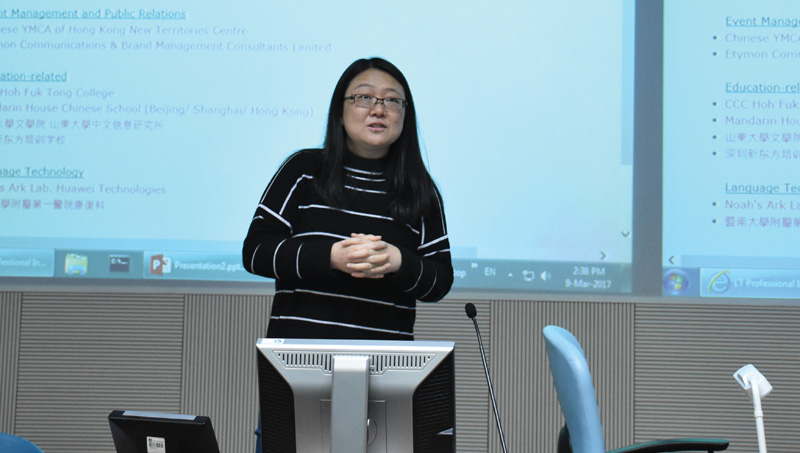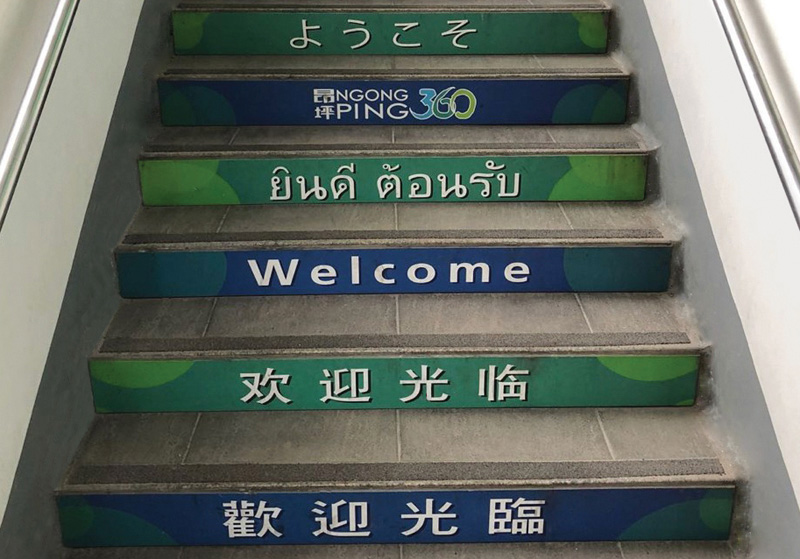Rediscovering Hong Kong by Surveying its Linguistic Landscape
A new teaching method proposed in a funded project motivated students to identify and analyse interesting linguistic phenomenon in the city“Linguistic diversity is a key feature of Hong Kong’s society.” So says Dr LI Bin, Associate Professor of Department of Linguistics and Translation of CityU’s College of Liberal Arts and Social Sciences, who has completed a project to implement an innovative teaching method that helps students relate classroom knowledge to everyday situations, and sensitise them to language phenomenon in Hong Kong.
Entitled “(Re)discovering Hong Kong through surveying its linguistic landscape”, the project saw students discover the diverse local linguistic and social characteristics through collaborated survey of the city’s unique linguistic landscape. They had to take photos of textual signs and write a short report to describe and analyse the linguistic and sociocultural issues reflected in the signage. An annotated digital photo album and an interactive map were then created by the teachers to integrate the photos and to highlight discoveries.
Language is a hugely important facet of any society, explains Li. She states, “Majority and minority languages in official and informal texts show a myriad of patterns of language use. They are a reflection and result of historical, ideological, social, ethnic considerations via language choices.”
Li describes Hong Kong’s language system as “concordance and heterogeneity under trilingualism and biliteracy with the mainstream use of bilingual or monolingual signs in Chinese/English, and a myriad use of minority languages in diverse contexts for official and commercial purposes.”
According to Li, language has a dramatic effect on the socioeconomic and cultural elements of the city.
“Language is an inherent means to individual and group identities,” she says. “Impacts of intrinsic and extrinsic choices of a language or accent are observable and experienced in all aspects of life from kindergarten admission and professional communication to even visibility of a commercial sign. So, awareness of linguistic diversity, including language choices and speech accents, contributes to a proper understanding of Hong Kong and its people in the past and at present, which benefits social inclusiveness and cultural accommodation.”
Majority and minority languages in official and informal texts show a myriad of patterns of language use. They are a reflection and result of historical, ideological, social, ethnic considerations via language choices
Dr Li Bin
Hong Kong is a particularly rich melting pot of languages. Although Cantonese is dominant, many of the city’s Chinese residents also speak other Chinese dialects such as Hakka, Fukien and Tewchau (Chiuchau), as well as Putonghua, the dominant language in mainland China. Furthermore, Hong Kong’s South Asian communities continue to speak their heritage languages such as Hindi or Urdu, while English, one of Hong Kong’s official languages, remains an essential language for many.
Although some predicted a less international Hong Kong following the handover in 1997, Li believes the city is as rich linguistically as it was over 20 years ago.
“In my understanding, the language landscape has not changed dramatically over the decades,” says Li, who based her assessment off her research projects and by researching public media and scholarly works. “Bilingual signs and monolingual ones in standard Chinese/ English still account for the majority of publicly displayed textual signs, which is similar to the description of the 1990s.”
Li credits her students and collaborating course leaders for helping to make her project such a success. She says they went to great lengths to look at Hong Kong from a unique linguistic lens.
“We set out to experiment with a teaching method that fosters discovery and critical thinking,” she explains. “Students formed groups and brainstormed for topics and analysis, before stepping outside the classroom to explore their hometowns from a different perspective. The collaboration not only offered opportunities for self-learning of linguistic concepts, but also fostered a greater appreciation of their own heritage and others.”
Li says students browsed the Central Library to find old maps and public documents to research the history of street names. Some interviewed restaurant owners and customers to understand the meanings behind shop signs and “funky menus” in restaurants. Some reached out to ethnic minority groups to verify translations of flyers in minority languages. These field trips and searching for textual signs were designed to help motivate students into the self-initiated inquiry of information and post-task reading.
The students’ projects had studied many issues in linguistics and sociolinguistics. For example, one group of students did a sociolinguistic discussion on a government notice. They examined the use of English as a lingua franca for inferential purposes and the use of colloquial Cantonese for affective purposes like cultural solidarity. They also looked at the linguistic features including phonological borrowing and morphological and semantic processes on the notice. In another example, the students took a photo of a signage of a foreign exchange shop with the business nature of the shop in Chinese, English, French and other languages used by ethnic minorities. They discussed issues such as translation strategy, business translation, and multilingualism in their report.
The aim of the project was to help students discover the diverse local linguistic and social characteristics of Hong Kong’s unique linguistic landscape. The sharing of their discoveries with overseas students then enabled them to understand the perspectives of others towards their home languages and cultural heritages. This exploration and discussion of the city’s linguistic landscape provided hands-on experience for students studying abstract and theoretical concepts in humanities and social sciences. Perhaps most importantly, the exercise aimed to help Hong Kong students appreciate their own heritage and bolster their local pride and global awareness by exploring the contextual and social use of languages as reflected in the cityscape.
“Through it all,” concludes Li, “students from diverse disciplines and cultural backgrounds gained a better understanding of themselves and the city through exploration of languages in the society. Their commitment and coursework make this project possible and a sustainable success.”




